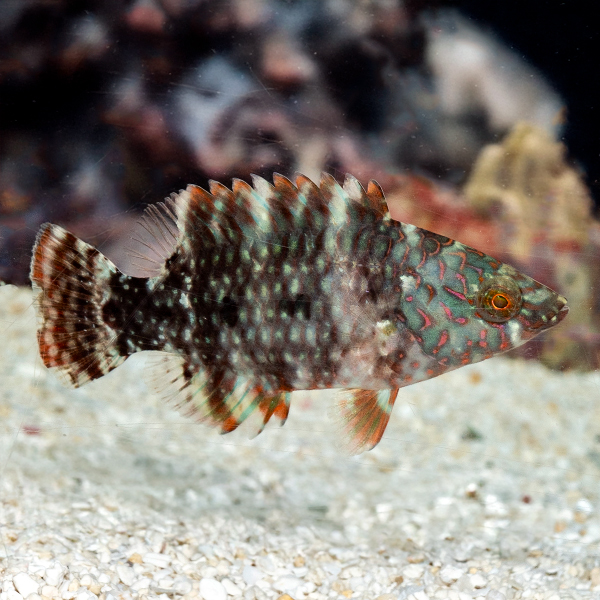
Additional locales and sizes may be available!
Additional locales and sizes may be available! Email me when availableQuick Stats
What do these Quick Stats mean? Click here for more information
What do these Quick Stats mean? Click here for more information
Overview
The Broomtail Wrasse Cheilinus lunulatus is a rare marine species that is spectacularly colored. While a juvenile has muted colors, its coloration becomes more intense as it moves into adulthood. Patterns on its body also change with maturity. Juveniles display an olive colored face with muted vertical stripes of gray and white across its body. The most distinctive feature at this stage is an orange flush of color on its pectoral fins. As an adult, a thick white band of color separates its green head from its navy blue posterior. In addition, it sports orange pectoral fins and a spectacular whiskered tail. A male will typically have more vibrant coloration and longer fins than the female.
It can grow to a maximum size of twenty inches, but twelve to fourteen inches is more common in the aquarium trade. Born female, this saltwater fish can change to a male later in life.
Although the Broomtail Wrasse will make its home in coral rich reefs or sandy habitats in nature, it is a predator and not reef safe. This hardy marine fish requires a large aquarium that will provide space to swim and plenty of hiding places, such as those that live rock offer. It has a habit of rearranging rocks and sand that is entertaining to watch, but this also means that rocks should be placed securely on the substrate floor.
Because of its semi-aggressive personality and propensity to show aggression toward smaller or similarly shaped fish and consume some invertebrates, it is best suited to a Fish Only With Live Rock (FOWLR) aquarium setup. Cheilinus lunulatus can even be territorial with others of its own species, so is best to let one Broomtail Wrasse be the feature specimen.
This member of the Labridae family is a carnivore that will consume a large amount of food when it eats, then may not feed for a day or days afterward. It requires a varied diet of meaty fish, shrimp, and crustacean foods.
Approximate Shipping Size: 3" to 4"











